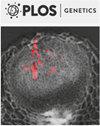一种单羧酸转运蛋白拯救额颞叶痴呆和阿尔茨海默病模型
IF 3.7
2区 生物学
Q1 Agricultural and Biological Sciences
引用次数: 0
摘要
大脑是新陈代谢非常活跃的器官,在静息状态下消耗生物体20%的能量。葡萄糖代谢下降是许多神经退行性疾病的共同特征。另一个共同特征是不溶性蛋白质沉积物的逐渐积累,目前尚不清楚这两者是否有联系。大脑中的葡萄糖代谢在神经元和神经胶质之间是高度耦合的,葡萄糖被神经胶质吸收并代谢成乳酸,然后通过转运体穿梭到神经元,在那里它被转化回丙酮酸,并进入三羧酸循环以产生ATP。单羧酸盐也参与信号传导,并在大脑稳态和代谢重编程中发挥广泛作用。然而,单羧酸盐在痴呆症中的作用尚未得到测试。在这里,我们发现通过转运蛋白bumpel的过度表达增加果蝇神经元中丙酮酸的进口,导致额颞叶痴呆和阿尔茨海默病的果蝇模型的寿命和行为表型的拯救。这种拯救与晚期自溶酶体的清除有关,导致与疾病相关的有毒肽的降解。我们建议上调丙酮酸输入神经元作为一种潜在的广泛的治疗方法来增加神经元自噬,这可能对多发性痴呆有益。本文章由计算机程序翻译,如有差异,请以英文原文为准。
A monocarboxylate transporter rescues frontotemporal dementia and Alzheimer’s disease models
Brains are highly metabolically active organs, consuming 20% of an organisms’ energy at resting state. A decline in glucose metabolism is a common feature across a number of neurodegenerative diseases. Another common feature is the progressive accumulation of insoluble protein deposits, it’s unclear if the two are linked. Glucose metabolism in the brain is highly coupled between neurons and glia, with glucose taken up by glia and metabolised to lactate, which is then shuttled via transporters to neurons, where it is converted back to pyruvate and fed into the TCA cycle for ATP production. Monocarboxylates are also involved in signalling, and play broad ranging roles in brain homeostasis and metabolic reprogramming. However, the role of monocarboxylates in dementia has not been tested. Here, we find that increasing pyruvate import in Drosophila neurons by over-expression of the transporter bumpel, leads to a rescue of lifespan and behavioural phenotypes in fly models of both frontotemporal dementia and Alzheimer’s disease. The rescue is linked to a clearance of late stage autolysosomes, leading to degradation of toxic peptides associated with disease. We propose upregulation of pyruvate import into neurons as potentially a broad-scope therapeutic approach to increase neuronal autophagy, which could be beneficial for multiple dementias.
求助全文
通过发布文献求助,成功后即可免费获取论文全文。
去求助
来源期刊

PLoS Genetics
生物-遗传学
CiteScore
8.10
自引率
2.20%
发文量
438
审稿时长
1 months
期刊介绍:
PLOS Genetics is run by an international Editorial Board, headed by the Editors-in-Chief, Greg Barsh (HudsonAlpha Institute of Biotechnology, and Stanford University School of Medicine) and Greg Copenhaver (The University of North Carolina at Chapel Hill).
Articles published in PLOS Genetics are archived in PubMed Central and cited in PubMed.
 求助内容:
求助内容: 应助结果提醒方式:
应助结果提醒方式:


